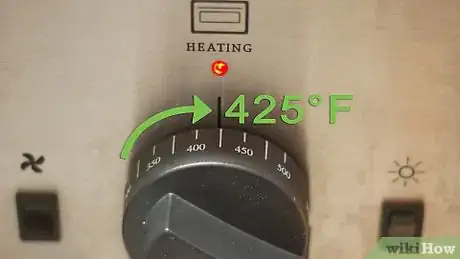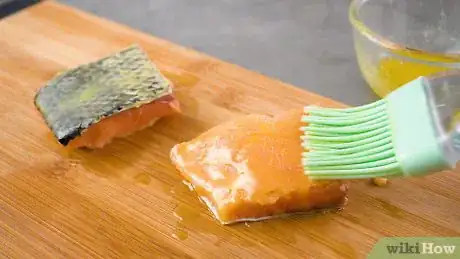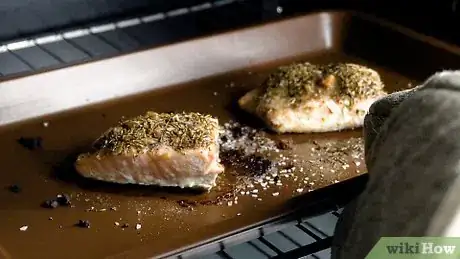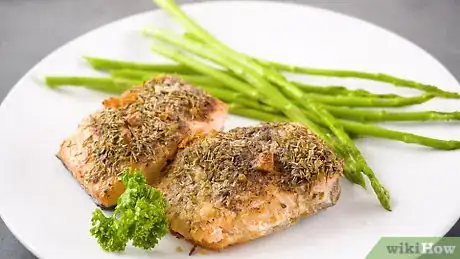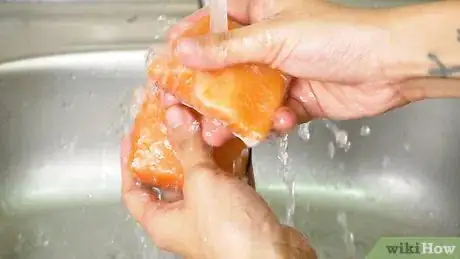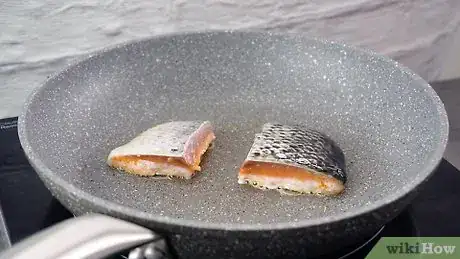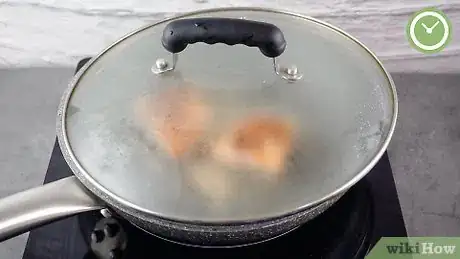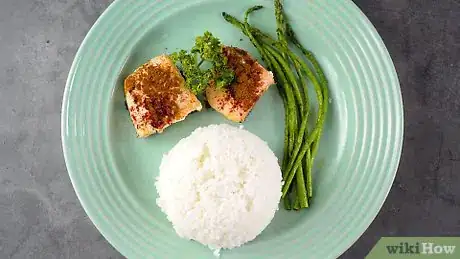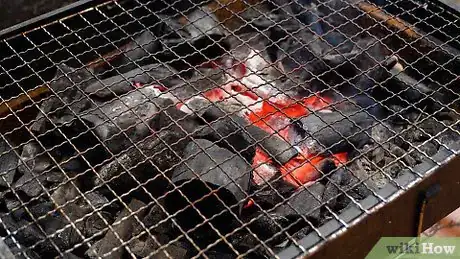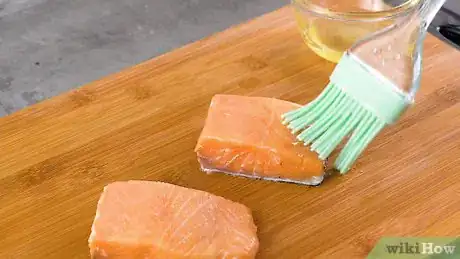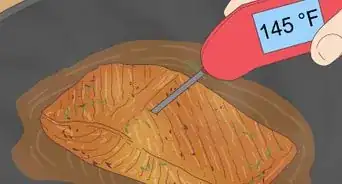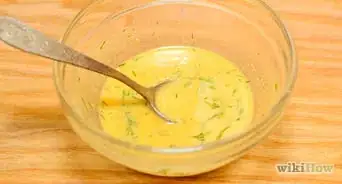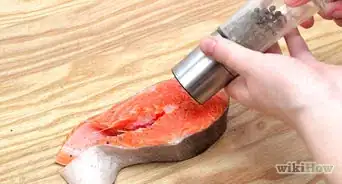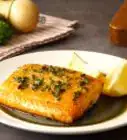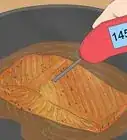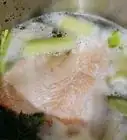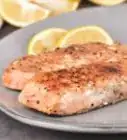This article was co-authored by Ollie George Cigliano and by wikiHow staff writer, Jessica Gibson. Ollie George Cigliano is a Private Chef, Food Educator, and Owner of Ollie George Cooks, based in Long Beach, California. With over 20 years of experience, she specializes in utilizing fresh, fun ingredients and mixing traditional and innovative cooking techniques. Ollie George holds a BA in Comparative Literature from The University of California, Berkeley, and a Nutrition and Healthy Living Certificate from eCornell University.
There are 10 references cited in this article, which can be found at the bottom of the page.
wikiHow marks an article as reader-approved once it receives enough positive feedback. This article received 15 testimonials and 100% of readers who voted found it helpful, earning it our reader-approved status.
This article has been viewed 981,844 times.
Having a bag of salmon fillets in the freezer guarantees that you can throw together a fast meal. Since most fillets are thin, you can safely cook them without defrosting them first. Just decide if you want to make them on the stove, in the oven, or on the grill. While the salmon is cooking, you can prep flavorful sides. Dinner will be on the table before you know it!
Ingredients
- 2 frozen salmon fillets, about 4 to 6 ounces (110 to 170 g) each
- 1 tablespoon (15 ml) of melted butter or olive oil
- 2 to 3 teaspoons (4 to 6 g) of your favorite spice mix
Makes 2 servings
Steps
Roasting Frozen Salmon in the Oven
-
1Preheat the oven to 425 °F (218 °C) and rinse 2 salmon fillets under cold water. Remove 2 frozen salmon fillets from their packaging and rinse them under the tap just until pieces of ice melt off.[1]
Remember that there's no need to thaw the fillets. Rinsing them quickly to remove the ice will prevent the fish fillets from becoming soggy as they cook.
-
2Pat the salmon dry and brush each side with melted butter. Use a paper towel to pat the moisture off of the fillets. Then, melt 1 tablespoon (15 ml) of butter into a small dish and dip a pastry brush into it. Brush each side of the salmon with the butter.[2]
- If you prefer to use a different cooking fat, you could use regular olive (also called light), canola, or coconut oil.
Advertisement -
3Put the fillets skin-side down into a pan and season the fish. You can use any herbs or spices you like. For a simple seasoning, sprinkle 1 teaspoon (5 g) of kosher salt, 1/4 teaspoon (0.5 g) of ground black pepper, 1/2 teaspoon (1 g) of garlic powder, and 1/2 teaspoon (1 g) of dried thyme over the fillets.[3]
Variation: Try flavoring the salmon with cajun seasoning, barbecue dry rub, maple syrup glaze, or a lemon-pepper seasoning.
-
4Cover the baking dish and cook the salmon for 10 minutes. Cover the baking dish tightly so no steam can escape as the fish cooks. Put the dish in the preheated oven and cook the salmon until it releases liquid.[4]
- Covering the pan as the fish starts to cook will help it stay tender and prevent it from drying out.
-
5Uncover the salmon and bake it for another 20 to 25 minutes. Wear oven mitts to peel the sheet of aluminum foil off of the dish and ensure that the escaping steam doesn't burn you. Roast the uncovered salmon until it reaches 145 °F (63 °C) with an instant-read thermometer.[5]
- If your fillets are thin [under 1 inch (2.5 cm)], check them after 20 minutes. Wait until closer to 25 minutes if the fillets are over 1 1⁄2 inches (3.8 cm) thick.
-
6Remove the salmon and rest it for 3 minutes before serving. Set the baking dish on a rack and leave the fish to rest. The fillets will finish cooking and will reabsorb some of the liquid. Then, transfer the fillets to plates and serve the fish with your favorite sides, such as roasted vegetables, steamed rice, or a garden salad.[6]
- Refrigerate leftover salmon in an airtight container for up to 3 to 4 days.
Pan-Searing Frozen Salmon
-
1Heat a skillet over medium-high and rinse 2 salmon fillets under cold water. Set a heavy skillet on the stove and turn the burner on while you get the salmon out of the freezer. Remove it from the packaging. Run cold water in the sink and hold the fillets under the tap until pieces of ice melt off of the fish.[7]
- You can use a nonstick or cast-iron skillet.
-
2Pat the salmon fillets with a paper towel and brush them with oil. Dry each side of the salmon with the paper towel and set them on a plate. Then, brush each side with olive oil. This will season the salmon and prevent it from sticking to the skillet.[8]
- Drying the salmon will help the skin crisp in the skillet.
Tip: If you'd like to use extra-virgin olive oil, wait until the fish is cooked to drizzle a little over it. Extra-virgin olive oil could burn with the high heat.
-
3Place the fillets in the skillet and cook them for 3 to 4 minutes. Lay the salmon into the hot skillet so they're flesh-side down. Keep the lid off of the skillet and cook the salmon over medium-high heat until the flesh has browned.[9]
- You can carefully shake the pan a few times as the salmon cooks to loosen the salmon and keep it from sticking.
-
4Flip the fillets and season them. Use a spatula to carefully flip each fillet over in the skillet. Then, sprinkle the fish with 2 teaspoons (4 g) of equal amounts of onion powder, paprika, and cayenne pepper if you'd like a smoky, spicy flavor.[10]
- Alternatively, you could use your favorite spice blend, such as Old Bay, cajun seasoning, or dry barbecue rub.
-
5Cover the skillet and cook the salmon for 5 to 8 minutes over medium heat. Set the lid on the skillet so it traps moisture and prevents the fish from drying out. Then, turn the burner down to medium and cook the fish until it's flaky in the center. To ensure the fish is done, you can insert an instant-read thermometer to see if the fish reaches 145 °F (63 °C).[11]
-
6Rest the salmon for 3 minutes before you serve it. Move the fillets to serving plates and get out side dishes while the fish rests. Try serving the pan-seared salmon with stir-fried vegetables, roasted potatoes, or wild rice.
- The salmon will cook a little more as you let it rest, so it's okay if you remove it a little bit early.
- Refrigerate leftover salmon in an airtight container. You can store the fish for up to 3 to 4 days.
Grilling Frozen Salmon
-
1Heat a gas or charcoal grill to high. If you're using a gas grill, turn the burners to high. If you're using a charcoal grill, fill a chimney with briquettes and light them. Dump the briquettes onto the grill once they're hot and lightly covered with ash.[12]
- If you'd like your salmon to have a smoked flavor, add a handful of soaked woodchips to the grill.
-
2Rinse 2 frozen salmon fillets under cold water. Get out 2 fillets that are about 4 to 6 ounces (110 to 170 g) each and remove them from their packaging. Run cold tap water and hold the fillets under the water so ice on the surface of the fish melts.[13]
- You can also use salmon steaks that are around the same size.
-
3Pat the salmon dry and brush it with olive oil. Take a paper towel and pat each side of the salmon with it to remove moisture. Pour 1 tablespoon (15 ml) of olive oil into a small dish and dip a pastry brush into it. Brush each side of the salmon with the oil.[14]
- If you don't have olive oil, use vegetable, canola, or coconut oil, since these can withstand the high heat of the grill.
- The oil will prevent the salmon from sticking to the grill grate.
-
4Season your salmon with 1 tablespoon (6 g) of a dry rub. You can use your favorite seasoning rub or mix up a barbecue dry rub. Combine 1 teaspoon (4 g) of brown sugar with 1 teaspoon (2 g) of paprika, 1/2 teaspoon (1 g) of onion powder, 1/2 teaspoon (1 g) of garlic powder, and a pinch of ground black pepper.[15]
Tip: Avoid spreading sweet sauces, such as barbecue sauce, on the salmon since these will burn. If you'd like to flavor the salmon with a sweet sauce, wait until the last few minutes of grilling time before brushing it on the fish.
-
5Lay the salmon on the grill and cook it for 3 to 4 minutes. Place the fish skin-side down on the grate and put the lid on the grill. Leave the salmon to cook without turning it or lifting the lid.[16]
- The skin shouldn't stick to the grill because you oiled it.
-
6Flip the salmon and grill it for another 3 to 4 minutes. Wear oven mitts to lift off the lid and use a spatula to carefully flip each fillet over. Put the lid back on the grill and let the fish finish cooking.[17]
- You should see definite grill marks on the salmon skin once you flip it over.
-
7Remove the salmon once it reaches 145 °F (63 °C) and rest it for 3 minutes. Insert an instant-read thermometer into the thickest part of a salmon fillet. You can transfer the fish to a serving platter once the fish reaches 145 °F (63 °C) and let it rest a few minutes while you get side dishes ready.[18]
- Store leftover grilled salmon in an airtight container in the refrigerator for up to 3 to 4 days.
Community Q&A
-
QuestionWhat spices do you suggest?
 Community AnswerHere are six ideas for spice/flavor combinations for salmon: 1. cumin, cinnamon, a dash of red pepper flakes, salt, and some brown sugar. Squeeze fresh lemon juice all over. (I call this BBQ salmon.) 2. thyme, salt, pepper, and a drizzle of honey (This is a particular favorite for grilling salmon.) 3. fresh dill, lemon juice, salt, pepper, and a pat of butter 4. ginger, garlic, and soy sauce 5. fresh tarragon and a pat of butter 6. Dijon mustard, fresh parsley, salt and pepper
Community AnswerHere are six ideas for spice/flavor combinations for salmon: 1. cumin, cinnamon, a dash of red pepper flakes, salt, and some brown sugar. Squeeze fresh lemon juice all over. (I call this BBQ salmon.) 2. thyme, salt, pepper, and a drizzle of honey (This is a particular favorite for grilling salmon.) 3. fresh dill, lemon juice, salt, pepper, and a pat of butter 4. ginger, garlic, and soy sauce 5. fresh tarragon and a pat of butter 6. Dijon mustard, fresh parsley, salt and pepper -
QuestionSo I can steam them from frozen? For how long?
 Community AnswerThere really is no solid time limit. If you put your stove on low, then I would say about an hour. If you set the stove on medium, it would take about 30 minutes.
Community AnswerThere really is no solid time limit. If you put your stove on low, then I would say about an hour. If you set the stove on medium, it would take about 30 minutes. -
QuestionDoes it matter how thick the salmon is?
 Community AnswerIf your salmon pieces are thicker, you can cook them for an additional 5 minutes or so.
Community AnswerIf your salmon pieces are thicker, you can cook them for an additional 5 minutes or so.
Things You'll Need
Pan-Seared Salmon
- Heavy skillet
- Paper towels
- Measuring spoons
- Spatula
- Serving plate
Oven-Roasted Salmon
- Paper towels
- Baking dish
- Aluminum foil
- Pastry brush
- Measuring spoons
- Spatula
- Instant-read thermometer
- Serving plate
Grilled Salmon
- Paper towels
- Measuring spoons
- Pastry brush
- Grill
- Spatula
- Instant-read thermometer
- Serving plate
References
- ↑ https://www.thekitchn.com/how-to-cook-frozen-salmon-247238
- ↑ https://healthyrecipesblogs.com/baked-salmon/
- ↑ https://healthyrecipesblogs.com/baked-salmon/
- ↑ https://www.thekitchn.com/how-to-cook-frozen-salmon-247238
- ↑ https://www.thekitchn.com/how-to-cook-frozen-salmon-247238
- ↑ https://www.thekitchn.com/how-to-cook-frozen-salmon-247238
- ↑ https://youtu.be/pIv16QYUIMs?t=29
- ↑ https://youtu.be/pIv16QYUIMs?t=48
- ↑ https://youtu.be/pIv16QYUIMs?t=61
- ↑ https://www.africanbites.com/oven-baked-salmon/
- ↑ https://youtu.be/pIv16QYUIMs?t=84
- ↑ https://youtu.be/vFE1DSYjVTc?t=106
- ↑ https://www.top40recipes.com/Frozen-Salmon-Cooking-Time-Instructions-For-Grilling-Baking.html
- ↑ https://www.top40recipes.com/Frozen-Salmon-Cooking-Time-Instructions-For-Grilling-Baking.html
- ↑ https://www.goodhousekeeping.com/food-recipes/a15720/bbq-rub-salmon-recipe-ghk0614/
- ↑ https://www.top40recipes.com/Frozen-Salmon-Cooking-Time-Instructions-For-Grilling-Baking.html
- ↑ https://www.top40recipes.com/Frozen-Salmon-Cooking-Time-Instructions-For-Grilling-Baking.html
- ↑ https://www.top40recipes.com/Frozen-Salmon-Cooking-Time-Instructions-For-Grilling-Baking.html
About This Article
To cook frozen salmon, start by pulling the salmon out of the freezer and rinsing it off with some cool water. After it is rinsed, pat the salmon dry with some paper towels and then brush both sides with some olive oil. To cook it in a pan, preheat a pan to medium high and then place the salmon skin-side up on the pan to let it sear. After 3 or 4 minutes, flip the salmon and sprinkle on your desired seasonings. Then, lower the heat to medium and cover the pan, letting the salmon cook for 7-8 minutes or until light pink. To learn how to cook frozen salmon in the oven or on the grill, scroll down.
